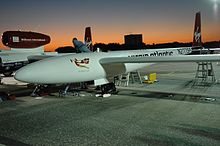


Inaerospace engineering, an aircraft's fuel fraction, fuel weight fraction,[1] or a spacecraft's propellant fraction, is the weight of the fuel or propellant divided by the gross take-off weight of the craft (including propellant):[2]

The fractional result of this mathematical division is often expressed as a percent. For aircraft with external drop tanks, the term internal fuel fraction is used to exclude the weight of external tanks and fuel.
Fuel fraction is a key parameter in determining an aircraft's range, the distance it can fly without refueling. Breguet’s aircraft range equation describes the relationship of range with airspeed, lift-to-drag ratio, specific fuel consumption, and the part of the total fuel fraction available for cruise, also known as the cruise fuel fraction, or cruise fuel weight fraction.[3]
In this context, the Breguet range is proportional to 
At today’s state of the art for jet fighter aircraft, fuel fractions of 29 percent and below typically yield subcruisers; 33 percent provides a quasi–supercruiser; and 35 percent and above are needed for useful supercruising missions. The U.S. F-22 Raptor’s fuel fraction is 29 percent,[4] Eurofighter is 31 percent, both similar to those of the subcruising F-4 Phantom II, F-15 Eagle and the Russian Mikoyan MiG-29 "Fulcrum". The Russian supersonic interceptor, the Mikoyan MiG-31 "Foxhound", has a fuel fraction of over 45 percent.[5] The Panavia Tornado had a relatively low internal fuel fraction of 26 percent, and frequently carried drop tanks.[6]
Airliners have a fuel fraction of less than half their takeoff weight, between 26% for medium-haul to 45% for long-haul.
| Model | MTOW (t) | OEW (t) | OEW Fraction |
Fuel capacity (t) |
Fuel fraction |
Payload Max. (t) |
Payload fraction |
|---|---|---|---|---|---|---|---|
| Airbus A380[7] | 575.0 | 285.0 | 49.6% | 254.0 | 44.2% | 84.0 | 14.6% |
| Boeing 777-300ER[8] | 351.5 | 167.8 | 47.7% | 145.5 | 41.4% | 69.9 | 19.9% |
| Boeing 777F | 347.8 | 144.4 | 41.5% | 145.5 | 41.8% | 102.9 | 29.6% |
| Boeing 777-200LR[8] | 347.5 | 145.2 | 41.8% | 145.5 | 41.9% | 64.0 | 18.4% |
| Boeing 767-300F | 186.9 | 86.1 | 46.1% | 73.4 | 39.3% | 54.0 | 28.9% |
| Airbus A350-1000[9] | 322.0 | 155.0 | 48.1% | 124.7 | 38.7% | 67.3 | 20.9% |
| Airbus A350-900[9] | 283.0 | 142.4 | 50.3% | 110.5 | 39.0% | 53.3 | 18.8% |
| Airbus A350F | 319.0 | 131.7 | 41.3% | 131.7 | 41.3% | 111.0 | 34.8% |
| Boeing 787-9[10] | 254.7 | 128.8 | 50.6% | 101.5 | 39.9% | 52.6 | 20.7% |
| Airbus A330-300[11] | 242.0 | 129.4 | 53.5% | 109.2 | 45.1% | 45.6 | 18.8% |
| Airbus A330-200[11] | 242 | 120.6 | 49.8% | 109.2 | 45.1% | 49.4 | 20.4% |
| Airbus A330-200F | 233 | 109.4 | 47.0% | 109.2 | 46.9% | 68.6 | 29.4% |
| Boeing 787-8[10] | 227.9 | 120.0 | 52.7% | 101.3 | 44.4% | 41.1 | 18.0% |
| Airbus A320ceo[12] | 79 | 44.3 | 56.1% | 23.3 | 29.5% | 20 | 25.3% |
| Boeing 737-800[13] | 79 | 41.4 | 52.4% | 20.9 | 26.5% | 21.3 | 27% |
| Bombardier CS300[14] | 70.9 | 37.1 | 52.3% | 17.3 | 24.4% | 18.7 | 26.4% |
| Bombardier CS100[14] | 63.1 | 35.2 | 55.3% | 17.5 | 27.7% | 15.1 | 23.9% |
| McDonnell Douglas MD-11F | 286.0 | 112.7 | 39.4% | 117.4 | 41.0% | 92.0 | 32.2% |
| Ilyushin IL-76TD-90VD | 195.0 | 92.5 | 47.4% | 90.0 | 46.2% | 50.0 | 25.6% |
| Boeing 747-8F | 447.7 | 197.1 | 44.0% | 181.6 | 40.6% | 132.6 | 29.6% |
| Concorde[15] | 185.1 | 78.7 | 42.5% | 95.7 | 51.7% | 12.7 | 6.9% |
| Virgin Atlantic Globalflyer[16] | 10.1 | 1.6 | 16.1% | 8.4 | 82.9% | 0.1 | 1.0% |
The Rutan Voyager took off on its 1986 around-the-world flight at 72 percent, the highest figure ever at the time.[17] Steve Fossett's Virgin Atlantic GlobalFlyer could attain a fuel fraction of nearly 83 percent, meaning that it carried more than five times its empty weight in fuel.[16]